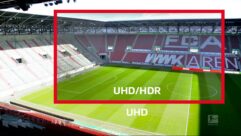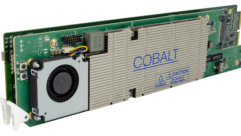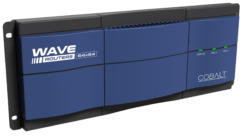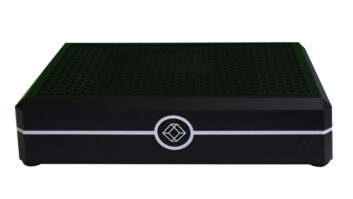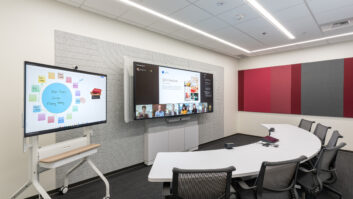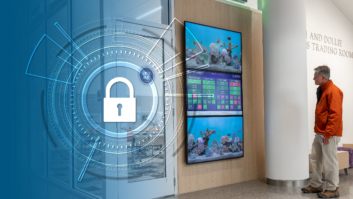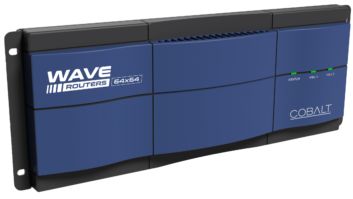Form and Function
Nov 1, 1999 12:00 PM,
Joyce Jorgenson
Designing and installing a distributed pew-back audio system for the Churchof the Holy Cross, Trenton, NJ, while preserving the sanctuary’s aesthetics.
Modern A-V technology has influenced today’s church designs to such adegree that it is hard to imagine a worship service without multiple micinputs, amps and maybe even wide-screen video presentation. For many largerchurches and cathedrals whose environments require the installation of A-Vsystems, however, there is still the issue of function versus aesthetics.This was precisely the concern of Monsignor Edward J. Arnister and DeaconJohn Grussler of the Church of the Holy Cross, Trenton, NJ. Built in 1910,this magnificent Polish-Catholic church was patterned after the basilicasof Italy as illustrated by its tiered columns, variegated marble surfaces,galleries of rich tapestry paintings and high vaulted ceilings. Itsinterior (20,000 ft superscript 2 or 1,858 m superscript 2) has thecapacity to seat 900 for each of its three Sunday mass services, two ofwhich are in English and one in Polish.
The original Church of the Holy Cross was constructed in 1891. Revered thenas a light of inspiration to immigrants seeking refuge from a politicallytorn Poland, this treasured house of worship has played a major spiritualrole in South Trenton’s community history. Today, its parishioners remainstaunchly committed to preserving both its heritage of hope andarchitectural grandeur.
It was within this context that Deacon Grussler first met with A-Vcontractors Tony Hersch and Brian Varhelyi of Audiobahn (Parker Ford, PA)to discuss the replacement of the church’s aging audio system, which hadbeen installed between 1949 and 1955 and upgraded in 1965. The new systemwas to include vocal reinforcement for the pulpit, altar and reading stand.Additional requests were made for a wireless lavalier for the priest andreinforcement for vocal soloists and such light instrumental music as pianoand acoustic guitar.
“When we first came on the scene, administrators at the church had alreadytalked with several other contractors,” Hersch said. “Church officials werenot happy with any of the proposals they had received at that point andwere greatly opposed to anything hanging from the ornate ceiling or mountedalong the Romanesque walls. A center cluster design was ruled outimmediately because of an enormous crystal chandelier, imported from LakeLucerne, Switzerland, located in the exact spot a center cluster wouldoccupy, but a distributed design was still in order.”
The distributed system proposed by Audiobahn did, however, take anunorthodox turn aimed at meeting all of the church’s audio expectations.Within the plan, the sanctuary’s harsh reverberation times were dealt withby decreasing the distance between the loudspeakers and the listeners.Thus, sound reinforcement requiring less energy would naturally reduce theamount of audio excitation present in the room. To maintain the aestheticswithin the sanctuary, Audiobahn proposed that 4.5 inch (114.3 mm) coaxialloudspeakers of high reproduction quality be mounted in a distributedpew-back configuration instead of in the walls or ceiling. Afterresearching the products available, they specified Atlas-SoundolierStrategy series FA134T47 drivers for the project based upon their highsensitivity and nominal dispersion of 130degree. Housing the transducerswas a job left to custom enclosures, also designed by Audiobahn, that wouldbe permanently affixed to the pews using a proprietary mou!nting system.
In the final design, Audiobahn placed the loudspeakers as close to the topof the pew-backs as possible, thereby allowing them to disperse soundwithin their full 130degree patterns to the listeners. At a listeningdistance of 2 feet (610 mm) from each loudspeaker, a circle of dispersionmeasuring 8.8 feet (2.7 m) in diameter was produced (at 1 kHz). Bystrategically placing the loudspeakers and overlapping their patterns,every listener wound up within range of at least one loudspeaker.
Within a typical overhead distributed system, there are no physicalobstructions in the path of the sound waves. Hersch admitted that onedrawback to distributing the system behind the pews was the actual physicalobstructions of the people seated therein, but he was quick to point outthat the obstructions in this case, being human, are absorbing, notreflective.
“I would never contend that physical obstructions had no effect on thesystem,” said Hersch, “but in this application, with the listeners so closeto the loudspeakers, their effect is minimal.”
To prove his point, Hersch demonstrated his design, which used asynergistic combination of the room’s live bass response below 250 Hz andthe reinforcement of the mid and high frequencies afforded by theAtlas-Soundolier coaxial loudspeakers mounted among the pews. The resultingperformance not only produced outstanding speech intelligibility, but itwas also capable of easily handling musical performances. Another attributeof the design is that feedback was virtually eliminated, therebyeliminating the need for automatic noise gating on the input end of theequation. Audiobahn began the system installation on May 6, 1999. Includingrunning all the necessary conduits, the entire job took only 16 days tocomplete.
Each custom loudspeaker enclosure was mounted on its respective pew,starting in the first row and continuing to the rear of the nave with everyother row receiving six of the Atlas-Soundolier FA134T47 loudspeakers. Atotal of 94 of the devices were used in all, placed as close to the top ofthe pew-back as possible to ensure that dispersion of the loudspeaker wasoptimized. Each pew section was permanently wired for its surmountingloudspeakers and then terminated to an electrical box underneath one end.Each loudspeaker’s wiring was nicely concealed in a molded wooden stripthat travels from the bottom of the loudspeaker down to the underside ofthe pew.
Four more Atlas-Soundolier FA134T47 loudspeakers were mounted in the choirloft for added reinforcement. Each loudspeaker transformer was tapped at 4W, well within the system’s total capability of 450 W produced by a CrownCT-410 power amp.
Trapezoidal in shape, the custom Audiobahn-designed loudspeaker enclosureswere built by Coffman Custom Cabinetry, Spring City, PA. By adding a15degree pitch to the top, they minimized each cabinet’s depth by 0.5inches (12.7 mm), which was essential to lessen obstruction when people areseated or moving through the pews while maintaining optimal enclosurevolume and porting to maximize sound quality. As a measure of protection,each enclosure was outfitted with a perforated steel grille covered byacoustically transparentfoam, which, in turn, is covered by a brown grillefabric for aesthetics.
“We tried our best to ensure that the drivers couldn’t be hurt in any way,”Hersch said. “The function of the foam in the grille structures is simplyto hide the steel. The holes in the perforated steel are so small you can’tget the point of a pen through it.”
On the input side of things, a Crown LM301A lectern-type mic with a highlyselective pickup pattern was permanently installed at the pulpit. AnotherLM301A was mounted on an Atlas-Soundolier MS10C mic stand to the left ofthe altar. A beyerdynamic S250P wireless lavalier mic system was providedfor the priest to wear during services.
“The beyerdynamic system provides good response,” Hersch said, “regardlessof whether it’s put on a tie or clipped on a collar. Rather than use acardioid or hypercardioid lavalier, we stuck with omnidirectional units forfreedom of placement without loss of signal or sound quality. We theninserted an Ashly PQX571 seven-band parametric EQ, which allows us to tunethe mic so that the priest can walk anywhere without feedback and stillmaintain natural voice reproduction.”
A white Crown PCC170 mic was placed on the altar to blend with the linencloth. Two Crown CM200ASW mics were mounted on Atlas-Soundolier MS10Cstands in the choir loft – one for the choir itself and one for theorganist. Two more CM200ASW/MS10C combinations with Atlas-Soundolier PB15boom extensions were placed on the stage area for use by the musical praisegroup which sometimes participates in the services. A Tascam CDA500combination CD/cassette player provides playback and recording functions.
Hersch said, “Because there are two separate outputs on the unit for the CDand cassette player, it’s possible to play both at once, or the praisegroup can play an accompanying CD through the system, and it can be madepart of a cassette recording of their performance.”
Two Anchor AN100 25 W portable powered monitors were mounted onAtlas-Soundolier DMS-10 mic stands and placed on either side of the chancelarea for monitoring. A single Atlas-Soundolier WD417-7V surface loudspeakerwith volume control was mounted to the wall in the sacristy to serve as apersonal cue and monitor for those members of the clergy waiting in thewings out-of-sight for their moment to join the service.
All input sources are routed to an Ashly MX508 8-channel rackmount mixerequipped with three-band, sweepable channel equalization and chosen for itsability to pack many of the same functions of a real pro mixing consoleinto 3 RU. Audiobahn has placed a large number of these units into similarenvironments with continuing success.
>From the MX508, signals are directed to an Ashly CLX51 compressor/peak>limiter as a safeguard against system overload. From the compressor, an>Ashly GQX-3101 provides system tuning, then the Crown CT410 amp delivers>ample power to each loudspeaker.
A 16 RU equipment rack was located in a closet in the sacristy to house allsystem electronics. The church preferred that the rack be in the closetrather than in plain view, which inadvertently helped shave some of theinstallation costs. The Middle Atlantic rack has a locking door and a 2 RUdrawer for storing the lavalier and handheld mics. Rack real estate alsoincludes a home for a Furman PS-PRO power conditioner and sequencer, whichguards against anyone turning the system on or off in the wrong sequence. Awall-mounted remote-control panel with an LED indicator and a keylock wasalso installed so that the system can be powered up or shut down withouthaving to open the rack.
Commenting on the finished product, Hersch said, “From any seat, the soundis there, as if the pastor is speaking directly in front of you. Inaddition, the fact that we can have seven open mics in the system withoutfeedback is something to tout. Normally, we would have put in gates or anautomatic mixer to manage this state of affairs, but in this design, itjust wasn’t necessary. We also gave this system a tremendous amount ofheadroom, so it can sit there andbasically idle and do whatever is requiredof it without ever working up a sweat.”
Both Monsignor Arnister and Deacon Grussler are happy with the system’shigh intelligibility and its ability to meet the aesthetic guidelines setforth.
Grussler said, “With the old system, some of our parishioners were able tohear the worship services only by sitting right up front. Now, these sameindividuals can sit anywhere in the church and still capture every detailof what is being said. That’s ultimate proof that this system works. Thefact that it does all this without negatively impacting the beauty of ourchurch makes its presence just as pleasing to the eye as it is to the ear.”
With aesthetic concerns totally dominating the audio design at the Churchof the Holy Cross, acoustical room treatments were not an option.Therefore, when it came to taming the sanctuary’s highly reverberantqualities, Audiobahn was forced to explore a number of creative options.The ultimate solution was to increase intelligibility via a reduction ofthe distances between the congregation and the loudspeakers, therebycreating a comprehensive, nearfield-like environment using a number ofdistributed sources mounted upon the backs of the pews. Gain levels wereminimized within the scheme as well, lessening the amount of acousticalenergy present in the room, and true to Audiobahn’s intent, the harshreverb times were made manageable.
Audiobahn’s Tony Hersch contends that the system’s underlying success isdue to critical listening techniques backed by a few fundamental principlesof math and physics. The latter took some old-fashioned preinstallationhomework.
The first order of business leading to the project’s completion was to mapout the loudspeaker specifications along with the system performance andcoverage requirements. To calculate the system performance requirementswithout clipping and distorting, Audiobahn naturally sought to discoverwhat the actual levels were that the application required.
“Because this is a speech-only application and because a fairly loudconversation takes place at about 75 dB, we wanted to exceed that by 10dB,” Hersch said. “From there, we looked at the sensitivity and powerratings of available loudspeakers. Then, we simply applied the logic of theinverse square law, which tells us that a doubling of power represents a3db increase in level, and a doubling of distance equals a 6dB leveldecrease.”
Using the Atlas-Soundolier FA134T47 coaxial loudspeaker, Audiobahncalculated that with sensitivity of 92 dB peak (1 W @ 1 m), theloudspeaker’s output at 2 W would be 95 dB, and 98 dB at 4 W (maximumtransformer tap) at 1 m away. In this particular design, the averagelistener is at a maximum distance of 1.5 m from a loudspeaker wherever heor she may be seated or standing. That translates into a 3 dB drop for alevel of 95 dB at full output of the loudspeaker.
Hersch said, “That doesn’t even take into account the summation of all theloudspeakers. With overall system compression at 10:1, we can easilyproduce 85 dB (10 dB over what is required) anywhere without clipping.”
Figure 1 shows the dispersion as well as a side view of theAtlas-Soundolier loudspeaker and its corresponding 130degree dispersion at2 kHz. By measuring 2.4 feet (731 mm) and 4.2 feet (1,280 mm) away from theloudspeaker, the diameters of the dispersion patterns were calculated. Whena listener is seated 2.4 feet from the loudspeaker, there is a circle ofdispersion measuring 8.8 feet (2.7 m). Likewise, when standing 4.2 feetfrom a loudspeaker, the dispersion circle measures 17.3 feet (5.3 m).
A second drawing, this time of the church pews and the proposed loudspeakerpositioning, was overlaid with the 8.8 feet dispersion patterns to confirmthat there would be 2 kHz coverage at the seated listening distance of 2.4feet. At a standing distance of 4.2 feet from the loudspeaker, the listenercomfortably falls within the dispersion pattern as well.
Because the pew itself has a 10degree tilt, Audiobahn added a 15degreedown-tilt to each loudspeaker’s baffle board and cabinet to doubly ensurethat all people seated or standing in the pews would fall within the 2 kHzdispersion circle, which is the optimum place to be for intelligibility.
Happily, the combined dispersion and performance characteristics of theFA134T47 loudspeakers created a working scenario within which oneloudspeaker in every other pew would more than adequately meet the soundcoverage requirements. The original plan had been to place a loudspeaker inevery pew to fill dispersion gaps. As it turned out, the church did notneed that many devices and saved significantly on installation costs.
“About 90% of our design work was obtaining the right loudspeaker,” saidHersch. “Everything else was academic. The first thing we did when weexamined the Atlas-Soundolier transducers was flip the page of thespecifications sheet and look at the polar plot to determineintelligibility (2 kHz), strength (500 Hz) and sibilance (4 kHz to 5 kHz)dispersion. Once the loudspeakers passed that test, it was evident duringour preliminary demonstration to church officials that they would easilyfulfill our performance demands and intelligibility requirements.”
Math and physics aside, Hersch tenaciously relies on his own hearing totune a sound system, a trait he acquired from a previous life spent on thetouring circuit. He said that in the final analysis, “calculations andmeasurement tools are invaluable for verification and documentationpurposes, but when all is said and done, listening is still the only truetest of this or any other system.”
You can contact Tony Hersch at Audiobahn, 610-495-6168 or e-mail [email protected].


